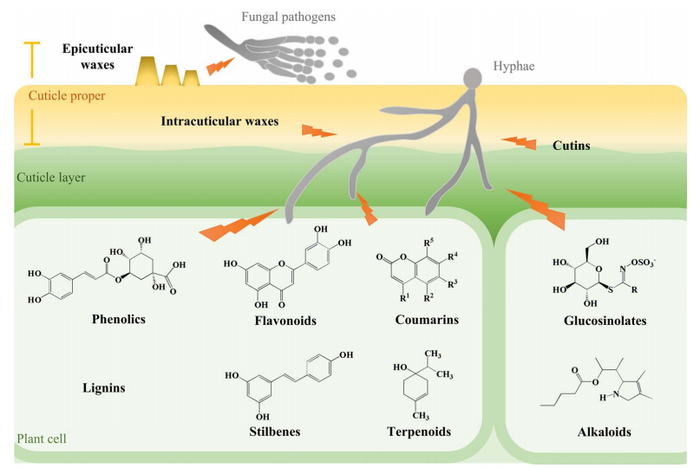Recent research on defense responses of horticulture crops to fungal infections, novel ways to govern the induction of plant resistance, issues, challenges, and future research objectives have been summarized by scientists from the Chinese Academy of Sciences.
 Physical barriers and phytochemicals involved in resistance of horticultural crops to fungal pathogens. Image Credit: Chinese Academy of Sciences
Physical barriers and phytochemicals involved in resistance of horticultural crops to fungal pathogens. Image Credit: Chinese Academy of Sciences
Antimicrobial phytochemicals are crucial elements of plants’ defense mechanisms. Among these phytochemicals, phytoalexins are brought about by outside forces, whereas phytoanticipins are either naturally occurring or growing because of induction.
According to their chemical makeup, antimicrobial phytochemicals are generally composed of phenolics, flavonoids, coumarins, lignins, terpenoids, alkaloids, glucosinolates, and stilbenes.
The secondary metabolites phenols and flavonoids make up one of the most prevalent and diverse categories of phytochemicals. These substances prevent the growth of infections by causing membrane lipid peroxidation, which interferes with the permeability of fungal cell membranes and mitochondrial activity.
Similar to this, terpenoids promote disease resistance while simultaneously inhibiting fungal development. The other phytochemicals also have potent and consistent broad-spectrum antifungal action, indicating that they may one day be used as natural fungicides in place of chemical ones.
Pattern recognition receptors (PRRs) may identify conserved damage-associated molecular patterns (DAMPs) from plants or pathogen-associated molecular patterns (PAMPs) from pathogens and activate pattern-triggered immunity when fungal pathogens breach physical barriers by altering or degrading host cell walls (PTI).
To be identified, nucleotide-binding and leucine-rich repeat (NB-LRR or NLR) proteins and other plant resistance (R) proteins may be able to recognize the effectors or virulence factors that fungal infections release.
Furthermore, effector-triggered immunity (ETI), which is proposed to be an accelerated and amplified PTI response, may result from such recognition. Various NB-LRR genes show distinctive evolutionary patterns in different plant species.
Only a small number of NB-LRR genes have so far been proven to work in response to fungi. Further in-depth research into possible NB-LRRs and their modes of action may significantly increase the effectiveness of our countermeasures against fungi.
Plants have evolved several defense mechanisms, including the hypersensitive response (HR), cell wall modification, stomatal closure, callose deposition, phytoalexin synthesis, and toxin breakdown, to stop the spread of fungal pathogens. Following the induction of local defense reactions, systemic signals may spur resistance in other nearby tissues.
Systemic acquired resistance (SAR) and herbivore-induced resistance can both be created by PTI and ETI by inducing the synthesis and long-distance transport of signaling molecules (HIR).
Salicylic acid (SA) signaling and N-hydroxypipecolic acid, to a lesser extent, are the main mechanisms via which SAR is mediated (NHP). In contrast to SAR, ethylene (ET) and jasmonic acid (JA) control HIR. It is typical and essential for defense responses against fungal infections for SA, JA, and ET to crosstalk, both synergistically and antagonistically.
The environment and food safety are at risk due to the misuse of conventional fungicides and antimicrobial treatments, which have promoted pathogen resistance to these substances.
To meet the needs for the sustainable development of the agricultural business, new approaches to disease management must be created. The most recent research shows that it is both feasible and effective to induce intrinsic resistance in horticulture crops via regulatory components.
There are now more opportunities for crop protection, thanks to the identification of cross-kingdom RNA trafficking. Small RNAs (sRNAs) are effectors that the necrotrophic fungus B. cinerea can create to inhibit host immunity. Through extracellular vesicles, host plants deliver sRNAs to B. cinerea that prevent the expression of genes linked to pathogenicity.
Transferred host sRNAs can either increase or decrease host resistance by being overexpressed or knocked down. Many eukaryotic microorganisms can absorb double-stranded RNA (dsRNA) from the environment with variable degrees of efficiency, and topical administration of dsRNA with high RNA uptake efficiency can significantly reduce the symptoms of plant diseases.
Another effective strategy to promote resistance in horticulture crops may involve modifying regulatory elements that govern mRNA translation. In eukaryotes, upstream open reading frames (uORFs) have a variety of regulatory roles that affect how mRNA is translated. Additionally, CRISPR/Cas9 makes it simple to create transgene-free lines of plants with enhanced features, which has significant implications for agricultural development.
Since uORFs are widely distributed in eukaryotic mRNAs, it is possible to modify these regulatory components to improve broad-spectrum resistance with no negative impact on normal growth, significantly advancing the genetic advancement of horticulture crops.
“Because of the importance of fungal disease in pre- and postharvest loss of horticultural crops, we focused on plant-pathogen interactions and control technology. Moreover, development and application of omics technologies have provided large data sets at multiple levels, which have further broadened insights into the defense responses against fungal pathogens,” Prof. Tian said.
The review report also looked at the limits of earlier research and suggested new lines of inquiry for horticultural crop resistance genetic enhancement.
Source:
Journal reference:
Xu, X., et al. (2022) Molecular mechanisms underlying multi-level defense responses of horticultural crops to fungal pathogens. Horticulture Research. doi.org/10.1093/hr/uhac066.